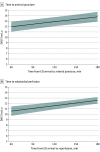Healthy Life-Year Costs of Treatment Speed From Arrival to Endovascular Thrombectomy in Patients With Ischemic Stroke: A Meta-analysis of Individual Patient Data From 7 Randomized Clinical Trials
- PMID: 33938914
- PMCID: PMC8094030
- DOI: 10.1001/jamaneurol.2021.1055
Healthy Life-Year Costs of Treatment Speed From Arrival to Endovascular Thrombectomy in Patients With Ischemic Stroke: A Meta-analysis of Individual Patient Data From 7 Randomized Clinical Trials
Abstract
Importance: The benefits of endovascular thrombectomy (EVT) are time dependent. Prior studies may have underestimated the time-benefit association because time of onset is imprecisely known.
Objective: To assess the lifetime outcomes associated with speed of endovascular thrombectomy in patients with acute ischemic stroke due to large-vessel occlusion (LVO).
Data sources: PubMed was searched for randomized clinical trials of stent retriever thrombectomy devices vs medical therapy in patients with anterior circulation LVO within 12 hours of last known well time, and for which a peer-reviewed, complete primary results article was published by August 1, 2020.
Study selection: All randomized clinical trials of stent retriever thrombectomy devices vs medical therapy in patients with anterior circulation LVO within 12 hours of last known well time were included.
Data extraction/synthesis: Patient-level data regarding presenting clinical and imaging features and functional outcomes were pooled from the 7 retrieved randomized clinical trials of stent retriever thrombectomy devices (entirely or predominantly) vs medical therapy. All 7 identified trials published in a peer-reviewed journal (by August 1, 2020) contributed data. Detailed time metrics were collected including last known well-to-door (LKWTD) time; last known well/onset-to-puncture (LKWTP) time; last known well-to-reperfusion (LKWR) time; door-to-puncture (DTP) time; and door-to-reperfusion (DTR) time.
Main outcomes and measures: Change in healthy life-years measured as disability-adjusted life-years (DALYs). DALYs were calculated as the sum of years of life lost (YLL) owing to premature mortality and years of healthy life lost because of disability (YLD). Disability weights were assigned using the utility-weighted modified Rankin Scale. Age-specific life expectancies without stroke were calculated from 2017 US National Vital Statistics.
Results: Among the 781 EVT-treated patients, 406 (52.0%) were early-treated (LKWTP ≤4 hours) and 375 (48.0%) were late-treated (LKWTP >4-12 hours). In early-treated patients, LKWTD was 188 minutes (interquartile range, 151.3-214.8 minutes) and DTP 105 minutes (interquartile range, 76-135 minutes). Among the 298 of 380 (78.4%) patients with substantial reperfusion, median DTR time was 145.0 minutes (interquartile range, 111.5-185.5 minutes). Care process delays were associated with worse clinical outcomes in LKW-to-intervention intervals in early-treated patients and in door-to-intervention intervals in early-treated and late-treated patients, and not associated with LKWTD intervals, eg, in early-treated patients, for each 10-minute delay, healthy life-years lost were DTP 1.8 months vs LKWTD 0.0 months; P < .001. Considering granular time increments, the amount of healthy life-time lost associated with each 1 second of delay was DTP 2.2 hours and DTR 2.4 hours.
Conclusions and relevance: In this study, care delays were associated with loss of healthy life-years in patients with acute ischemic stroke treated with EVT, particularly in the postarrival time period. The finding that every 1 second of delay was associated with loss of 2.2 hours of healthy life may encourage continuous quality improvement in door-to-treatment times.
Conflict of interest statement
Figures

References
-
- Powers WJ, Rabinstein AA, Ackerson T, et al. . Guidelines for the early management of patients with acute ischemic stroke: 2019 update to the 2018 guidelines for the early management of acute ischemic stroke: a guideline for healthcare professionals from the American Heart Association/American Stroke Association. Stroke. 2019;50(12):e344-e418. doi:10.1161/STR.0000000000000211 - DOI - PubMed
Publication types
MeSH terms
Grants and funding
LinkOut - more resources
Full Text Sources
Other Literature Sources
Medical

